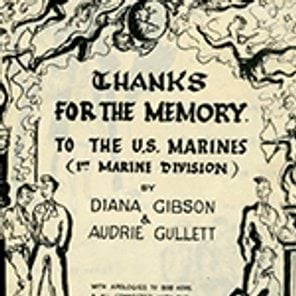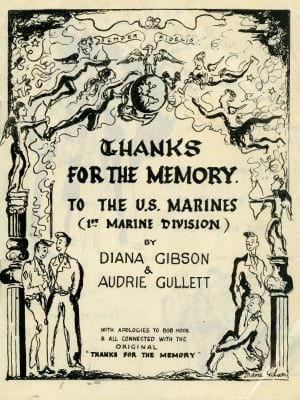
- Conflict:
- Second World War (1939-45)
- Services:
- Army, Air Force, Navy
The Second World War is remembered as one of the happiest times by many young women when an influx of American servicemen ‘on liberty’ transformed Melbourne into a bustling metropolis. Historically, it is known as a time many feared these same women would collectively lose their virtue to these charming American men in uniform. A small booklet, titled ‘Thanks for the memory’, held in the Shrine’s collection, does nothing to refute this notion with its tongue in cheek poem and whimsical illustrations by friends, Diana Gibson and Audrey Gullet.
Diana and Audrey lived near each other in the affluent suburb of Toorak. They were well connected and well known in both civil and military society, including among their connections Sir Henry Gullett MP and General Sir John Monash. They shared a love of the arts, attending art school together with another young friend, Ann Church. In 1939, media mogul Keith Murdoch arranged for an extraordinary exhibition of modern British and French art to travel to Australia’s major cities. On display in Melbourne Town Hall, the exhibition was open 10am until 10pm for almost two weeks, and Diana visited nearly every day.
The year of 1943 saw Melbourne overrun with a different group of international visitors—the men of the First Marine Division of the United States Marine Corps. They arrived on Melbourne’s doorstep for rest and recuperation following the gruelling and strategic victory of the Guadalcanal campaign in the Pacific theatre. Many of the young men were new recruits, with the majority under 20 years of age. From blue-collar backgrounds across the US, the Marines were eager to enjoy the offerings of the friendly Australians they encountered.
Diana and Audrey captured the highs and lows of the Marines and their time in Melbourne in a poem that parodied Bob Hope’s signature tune Thanks for the Memory. First introduced to audiences in the 1938 film The Big Broadcast, Hope and many others adapted the lyrics to create memorable parodies, including Marilyn Monroe who sang a verse to President Kennedy in 1962.
The satirical version penned and illustrated by the close friends is witty and deliberately provocative. The risqué poem is at once a light-hearted poke at the activities of the frivolous youth and a validation of the collective fears of society.
The poem and illustrations reference iconic Melbourne landmarks including the Shrine of Remembrance, Luna Park, Young and Jacksons and the Zoo. They note visits by notable Americans Artie Shaw, a popular band leader who toured the Pacific; and First Lady Eleanor Roosevelt, pictured in her distinctive American Red Cross Uniform. They talk ‘of drunks and fights and dreadful sights and whirling jitterbugs’ as Australian servicemen perceived the Americans as interlopers resulting in street brawls. The jitterbug dance, whilst popular in America, was only for ‘a certain kind of girl’ who didn’t mind showing her underwear. They write ‘of castles in the air, fingers in my hair, of Collins street, and kisses sweet, those medals that you wear’ whilst declaring at the end ‘PS We’ll get over it’. For two young women with well-established ties to the military it was a funny and audacious publication to produce.
The First Marine Division may have only been in Australia for around nine months but they took with them the hearts of Melbourne’s young women; a new battle hymn, Waltzing Matilda; and, a copy of Diana Gibson and Audrey Gullett’s poem that they published in the Divisions 1949 official history, attributed to ‘two Australian Red Cross girls’.
Author:
Jenna Blyth has over 14 years’ experience in sharing stories and caring for cultural materials at museums and galleries.
Updated
